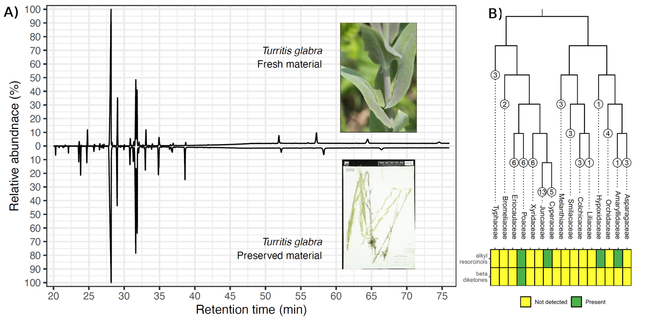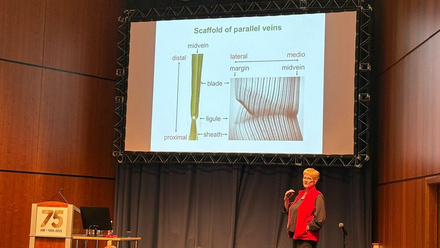September 2024 TPJ Editor choice: For old times’ sake: herbaria collections used to analyse plant surface waxes
Highlighting: “Herbarium specimens as tools for exploring the evolution of fatty acid-derived natural products in plants” https://doi.org/10.1111/tpj.16989
For old times’ sake: herbaria collections used to analyse plant surface waxes
Fitzgibbons et al. explored the potential of using preserved plant specimens from herbaria for chemical analyses, hypothesizing that these specimens might retain surface chemicals similar to those of living plants. They tested this by comparing waxes from fresh and herbarium samples across various plant lineages, including eudicots, monocots, gymnosperms, and ferns. They identified 11 classes of waxes in both fresh and preserved samples, such as very-long-chain n-alcohols, n-aldehydes, n-alkanes, alkyl esters, and fatty acids, which are common across all plant lineages. Some waxes were lineage-specific, like alkylresorcinols and very-long-chain secondary alcohols, diols, ketones, monoacyl glycerides, and triterpenoids. The study concluded that herbarium specimens could be used for analyzing wax composition.
Comparing the quantitative chemical profiles from fresh and preserved tissue of representative plant species, they found that in a principal component analysis, the profiles of the same plant species clustered closer together than the profiles of different plant species, even though some of the preserved samples were up to 100 years old, suggesting that the samples could be used for quantitative analysis.
To investigate the evolution of fatty acid-derived natural products, the authors analyzed the occurrence of alkylresorcinols and beta-diketones in monocot lineages. Using gas chromatography, they detected alkylresorcinols in Trichophorum cespitosum and beta-diketones in Hordeum jubatum. They then analyzed 57 monocot herbarium specimens across 15 monocot families, finding alkylresorcinols in at least one species of Poaceae, Cyperaceae, Orchidaceae, and Asparagaceae, while beta-diketones were only found in one Poaceae species, suggesting that alkylresorcinols evolved before beta-diketones.
The authors placed the chemistry data in a genomic context by searching monocot genome assemblies for type-III polyketide synthases, the enzymes that synthesize alkylresorcinol and beta-diketone. These enzymes were found in four clades that diversified after genome duplication, suggesting that genome duplication played a role in the functional diversification of these enzymes. To analyse the ancestral type-III polyketide synthase, the authors built a structural model, identified active sites in the protein, and checked conservation in the phylogeny. They found conserved sites in some alkylresorcinol synthases but not in beta-diketone synthases, indicating divergence in the amino acids surrounding the active sites. Eight active site-adjacent residues were highly conserved across alkylresorcinol synthases but not in beta-diketone synthases, suggesting that ancient polyketide synthases likely served as alkylresorcinol synthases.
Despite the potential of herbaria specimens for studying plant chemical diversity, there are limitations. Some plant species have surface chemicals present as large, fine crystals that can be rubbed off with minor abrasion, therefore the abundance of these chemicals on preserved specimens may not reflect their abundance on living plants. Additionally, the rate of degradation of chemical compounds in herbaria is not well understood, which could affect the relative abundances of compounds in preserved specimens.
Fitzgibbons et al. demonstrated that herbaria collections could be used for analyzing the compositional profiles of fatty-acid derived surface waxes. They hypothesize that any stable compound class preserved in herbarium specimens could potentially be detected, indicating a vast amount of chemical data stored in herbaria collections. With an estimated 350 million specimens in 3,400 herbaria worldwide, many digitized into databases with species, collection date, and geographical origin information, these collections represent a rich resource for studying metabolic evolution and discovering new natural products.

Figure 1: Specimen preserved in herbaria can be used to measure fatty-acid derived surface waxes.
A) The total ion chromatograms of Turritis glabra leaf samples of fresh or preserved samples show that the occurrence of some waxes can be detected in herbarium samples.
B) Alkylresorcinols are found in the Poaceae, Cyperaceae, Orchidaceae and Asparagaceae, but beta-diketones only in the Poaceae. Figure modified from (Fitzgibbons et al., 2024).





